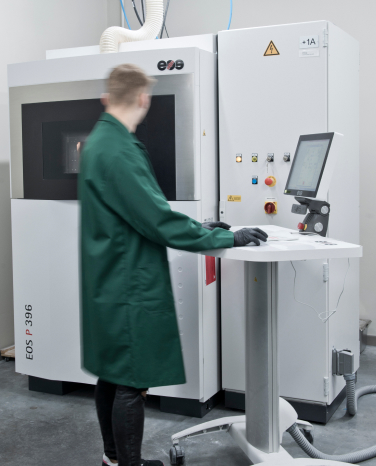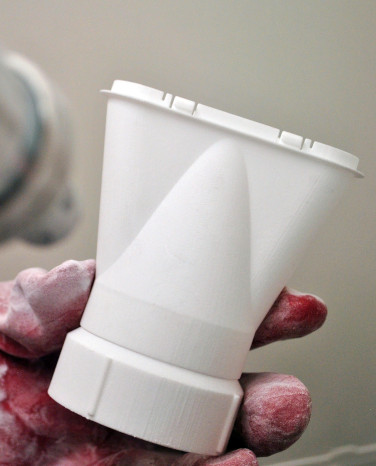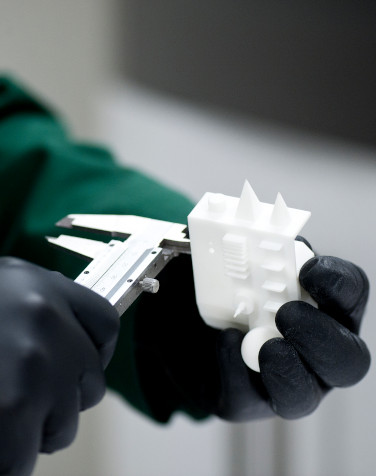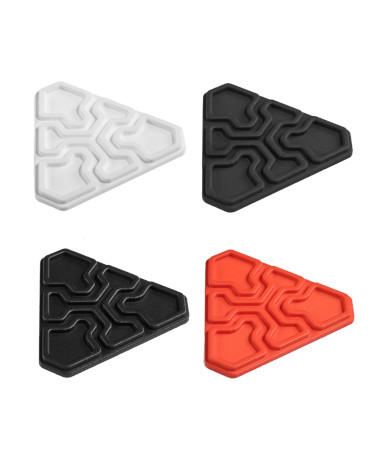3d printing SLS: selective laser sintering
Selective Laser Sintering (SLS) technology has one of the largest production potentials. Support structures are not required in the SLS process, which is a big advantage of this technology. The SLS system we use has a unique solution: open parameters, thanks to which we can optimize the technological parameters, adapting them to your application.
What are the benefits of SLS?

Benefit #1
Allows the use of different types of powders to produce items with a variety of mechanical properties.

Benefit #2
Does not require additional support for printing, making it possible to print complex geometry without having to remove additional support structures.

Benefit #3
It produces prints with high precision and also good surface quality, making it ideal for the production of complex parts.

Benefit #4
It enables rapid prototyping of sustainable materials, which is particularly beneficial in the design and prototyping process.
Materials
-
 Durable engineering material
Durable engineering material -
 Biocompatibility according to EN ISO 10993-1 & USP/level VI/121 °C
Biocompatibility according to EN ISO 10993-1 & USP/level VI/121 °C -
 Food Safe certificate in accordance with European Directive 2002/72/EC (excluding alcoholic products)
Food Safe certificate in accordance with European Directive 2002/72/EC (excluding alcoholic products) -
 High chemical resistance
High chemical resistance -
 The possibility of using advanced post-processing - more information in postprocessing
The possibility of using advanced post-processing - more information in postprocessing
Other names: PA2241FR (trade name). PA12 polyamide-based material with additives ensuring non-flammability of the material. The material is most commonly used in aviation and railways and wherever non-flammability is required.
-
 Fire resistance class: CS 25 / JAR25 / FAR 25 § 25-853 (a) App. F Part I, ABD 0031
Fire resistance class: CS 25 / JAR25 / FAR 25 § 25-853 (a) App. F Part I, ABD 0031 -
 Good mechanical properties
Good mechanical properties -
 High chemical resistance
High chemical resistance
-
 High impact strength
High impact strength -
 Eco
Eco -
 More flexibility compared to PA12
More flexibility compared to PA12 -
 Cytotoxicity certificate according to DIN EN ISO 10993-5
Cytotoxicity certificate according to DIN EN ISO 10993-5
-
 Low density
Low density -
 Low melting point
Low melting point -
 Relatively easy process of removing the lost model from the foundry mold
Relatively easy process of removing the lost model from the foundry mold -
 Reduced amount of ashes during burn out process
Reduced amount of ashes during burn out process
Costs and Lead Time
Costs and Lead Time
-
 Part volume (space in the machine working chamber)
Part volume (space in the machine working chamber) -
 Material used
Material used -
 Production series size
Production series size -
 Occurrence of complex spaces in terms of cleaning them from unseaed powder
Occurrence of complex spaces in terms of cleaning them from unseaed powder -
 Choosing express execution options
Choosing express execution options -
 Applied postprocessing
Applied postprocessing
Want to optimize costs?
Want to optimize costs?
SLS Design Principles
With SLS, we recommend that you follow these rules:

Minimum hole diameter 1.5 mm

Minimum wall thickness 1 mm

The minimum clearance for moving parts is 0.2 mm

Positioning pins should be at least 2 mm thick/medium

The dimensional tolerance in SLS is +/- 0.3 % of the dimension measured at the lower limit +/- 0.3 mm

In SLS it is not recommended to use massive cross-sections (above 4 mm). Of course, we produce massive walls (above 4 mm), but we take an individual approach to this

In confined spaces (if unseasted powder needs to be removed), use technical holes to evacuate the powder
Not sure about your design?
Not sure about your design?